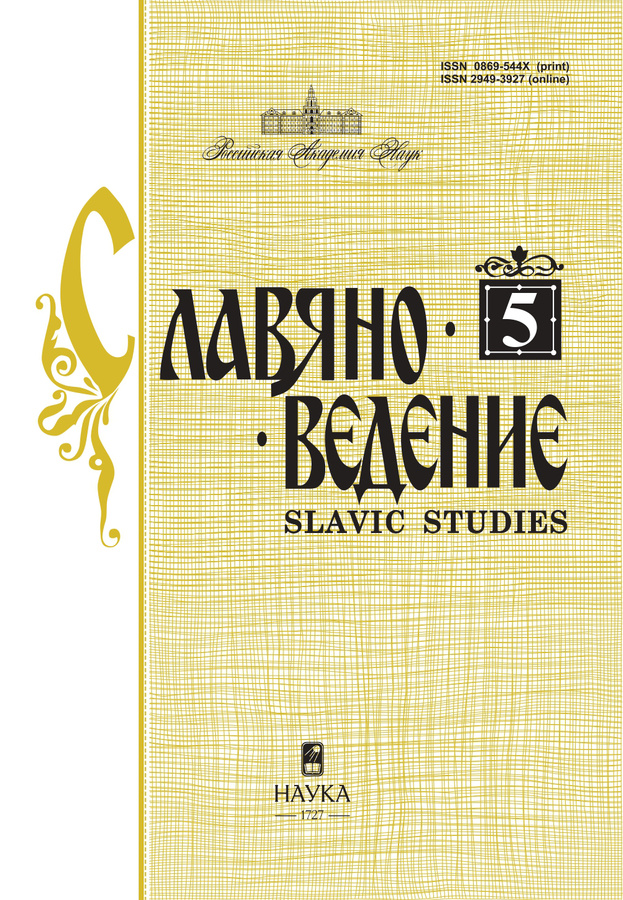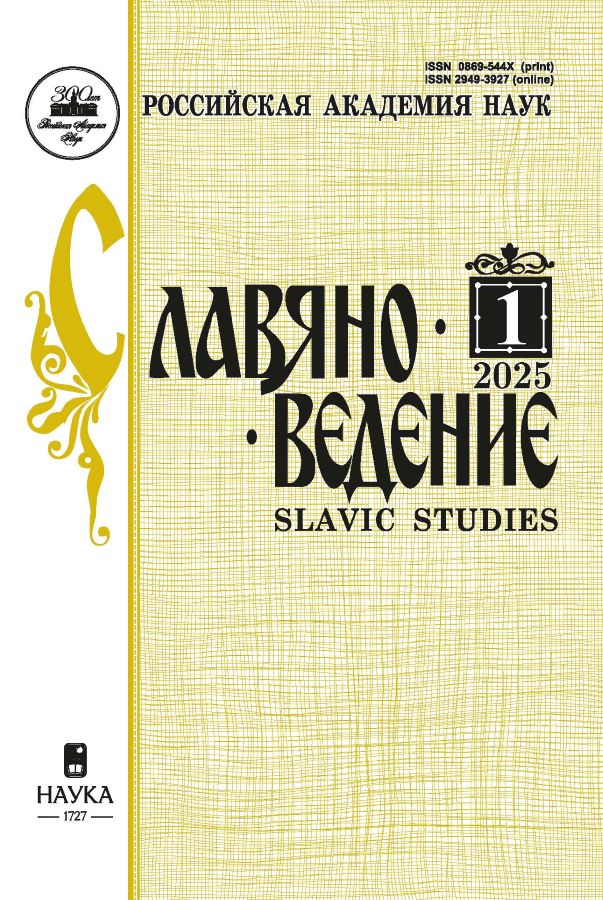№ 1 (2025)
Статьи
Определение донскими казаками XIX века своего места в этнокультурном пространстве Восточной Европы
Аннотация
В статье предпринята попытка реконструировать представление донских авторов XIX в. о месте донского казачества в этнокультурном пространстве Восточной Европы. Работы предшественников, характеризовавшие донское казачество с применением категорий «этнос» и «субэтнос» привели к противоречивым результатам: в то время, как наиболее авторитетные исследователи-этнографы (в частности, С.А. Токарев) относили часть донских казаков к русскому, а часть – к украинскому этносу, наиболее авторитетные историки (например, В.М. Кабузан) считали казаков субэтносом русского народа. Для того, чтобы разрешить это противоречие, специалист по казачьей этнографии М.А. Рыблова предложила исследовать место донского казачества в этнокультурном пространстве в динамике, с учетом «изменения социокультурной модели». Однако, она не вполне верно поняла специфику дискурса донских авторов и утверждала, что они считали казачество «этносословием». В статье показано, что для донских авторов XIX в. основой для самоидентификации донцов выступала принадлежность не к казачеству вообще, но к общности Донского Войска, которая не обладала чертами, свойственными этносу или субэтносу в традиционном понимании. Различными авторами по антропологическому типу, языку и характеру выделялось две или три группы донских казаков. Более того, донские авторы однозначно считали донское казачество общностью, отличавшейся от великороссов/малороссов, но при этом конструировали эту общность не через этничность, но через корпоративность, гордость историей Донского Войска, объединивших людей, различавшихся по языку, происхождению и даже вере. Язык, характер и антропологический тип, напротив, использовались для выделения различных групп внутри донского казачества, причем различия между ними подчеркивались – но не нарушали историко-корпоративного единства.
 5-21
5-21


Судьба русского эсера П.В. Злобина и проекты белорусской высшей школы (1918–1920 годы)
Аннотация
События 1918–1920-х годов стали завершающими в череде революций, войн и разрушений, которые низвели систему образования в белорусских губерниях до уровня начальной школы. Обескровленные кадры промышленности и сельского хозяйства требовали не только квалифицированных рабочих, но также техников и инженеров, способных настроить весь производственный процесс. В таких условиях национальные общественные организации и политические партии повсеместно поднимали вопросы о создании высшей школы. Ключевой фигурой в разработке проекта создания системы белорусского образования стал один из лидеров эсеров, заместитель председателя Минской губернской земской управы Павел Владимирович Злобин, отвечавший в 1918 г. за работу отдела образования. При его участии начала создаваться минская университетская комиссия, он поддержал проект Белорусского университета, представленный профессором М.В. Довнар-Запольским. Во многом благодаря его позиции мощную поддержку получил проект Минского политехникума, представленный председателем минского отделения Всероссийского союза инженеров, первым директором и будущим академиком АН БССР А.Д. Дубахом. Судьба П.В. Злобина тесно переплелась с Партией социалистов-революционеров, на его жизни отразилась борьба большевиков в 1920-е годы за создание однопартийной системы.
 22-33
22-33


«Колониальные первопроходцы»: пропаганда Морской и колониальной лиги среди крестьян Второй Речи Посполитой
Аннотация
В статье представлены результаты анализа адресованных крестьянам проектов строительства польской морской империи и их пропаганда. В разработанных Морской и колониальной лигой первой половины 1930-х годов проектах конструировался образ крестьянина-первопроходца, способного прочно обосноваться в бразильском штате Парана. Во второй половине 1930-х годов большей популярностью пользовались проекты финансовой поддержки крестьянами Фонда морской обороны и их службы в военно-морском флоте. Пропаганда в среде крестьян носила преимущественно устный характер. Принципиально важными авторам проекта представлялись экскурсионные поездки на Балтийское море и конкурс крестьянских сочинений на темы моря и заморских владений. Основная цель деятельности Лиги – упрочить национальное единство и интегрировать крестьянство в воображаемое пространство польской морской империи.
 34-45
34-45


Конфедерация «Свобода и независимость»: еще один неиспользованный шанс польских правых
Аннотация
Возникшая на рубеже 2018–2019 гг. Конфедерация «Свобода и независимость» представлена как очередная попытка правонационалистических сил закрепиться в польском парламенте и потеснить на правом фланге консервативную партию «Право и справедливость». В статье рассматриваются обстоятельства создания Конфедерации несколькими правыми группировками, ее участие в политической борьбе, идеология и программные установки. Показано, что Конфедерация пытается сочетать экономический либерализм с консерватизмом в отношении культуры и ценностей, а также с антиевропеизмом во внешней политике. Особое внимание уделено участию Конфедерации в парламентских выборах в октябре 2023 г. Они позволили ей немного увеличить представительство в сейме, но не изменили периферийное место в политической системе. Конфедерация не смогла привлечь к себе основную часть правого электората как вследствие присущей польским правонационалистическим партиям слабости, так и из-за специфики политической борьбы в Польше, где Конфедерация осталась в стороне от главного противостояния между партией «Право и справедливость» и стремившейся оттеснить ее от власти либеральной коалицией. Скорее всего, крайне-правые силы в Польше в ближайшей перспективе продолжат находиться на периферии политической сцены.
 46-58
46-58


Коннотативные значения «белого» в низшей мифологии славян в свете этимологии праслав. *běl-
Аннотация
Описание и номинация мифологических персонажей как белых уже привлекала к себе внимание исследователей. В данной статье акцент делается на выявлении контекстных, функциональных и коннотативных синонимов определения «белый» в демонологических поверьях и нарративах. Материал славянской демононимии показал, что «белый» является основным цветообозначением мифологических персонажей. В разных контекстах синонимичными белому оказываются определения «блестящий», «искрящийся», «сверкающий», «прозрачный» и под., которые в результате разнообразных семантических процессов притягивают ряд других определений, этимологически далеких от обозначения белого цвета, но функционально или символически заменяющих его, например, «красный» или «пестрый». Предпринимается попытка показать, что культурные и фольклорные значения мифологической лексики достаточно полно отражают реконструируемые древние этимологические значения корня *běl-, включая значения «огонь», «призрак», «туман». Отчасти в статье затрагивается тема обозначения мифологических персонажей как черных, но лишь в контексте противопоставления с белыми. Ситуации оппозиции «белый – черный» в номинациях и описаниях мифологических персонажей демонстрируют, что противопоставление обусловлено преимущественно аксиологическим восприятием демонов, где белый цвет и другая лексика, обозначающая светлый спектр, маркирует положительных или нейтральных персонажей, а черный – отрицательных.
 59-71
59-71


Тоска и ее контекстуальные «партнеры» в русских заговорах. 2.
Аннотация
В статье рассматриваются концептуальные «партнеры» тоски, в сопровождении которых тоска чаще всего появляется в русских заговорах. «Партнеры» тоски подбираются в заговорах не только к имени существительному тоска, но также к соответствующим глаголам, причастиям и прилагательным, причем такой ряд может достигать пяти-шести разных слов. В смысловом отношении «партнеры» тоски составляют несколько семантических ветвей, выявляемых на основе контекстуального анализа и диалектных значений. Первая ветвь представлена значением ‘иссушающее любовное чувство’ и лексемами сухота, чахота, вянота, а также соотносимыми с ними глаголами (сушить, присушивать, чахнуть, вянуть и др.). Вторая ветвь объединена значением ‘горе, печаль’, и в нее входит несколько лексем: прежде всего кручина (кручиниться) и горе (горевать), а также печаль (печалиться), грусть (грустить), тужить. Третья семантическая ветвь «партнеров» тоски имеет значение ‘забота, беспокойство, тревога’: его реализует собственно забота, а также дума. И, наконец, последнюю ветвь составляют слова, объединенные значениями ‘жалеть’, ‘любить’, – любовь, жалость и соответствующие глаголы.
 72-85
72-85


Аспектуальная интерпретация событий в заголовках новостных сообщений: различия в употреблении видов в русском и чешском языках
Аннотация
В данной статье сопоставление употребления форм глагольного вида в русском и чешском языках сфокусировано на заголовках новостных сообщений, с учетом дискурсивных особенностей последних. Основное внимание уделяется выражению событий в чешских заголовках формами прошедшего времени несовершенного вида (при возможном выборе видов). Исследование проводится в сопоставительном ракурсе, выявляющем различия в употреблении видов между двумя языками: при переводе подобных чешских заголовков на русский язык в большинстве случаев требуется употребление глаголов совершенного вида. Данная чешская дискурсивно обусловленная аспектуальная модель представления событий в процессе их реализации не была предметом специального изучения в славистике. Она встречается обычно в заголовках занимательных, криминальных и спортивных новостей и служит привлечению внимания читателей к описываемому событию. В статье проводится анализ условий и коммуникативно-прагматических эффектов использования данной аспектуальной модели в чешских газетных сообщениях последних пятнадцати лет.
 86-98
86-98


Сообщения
Библиотека Украинского научного института в Берлине: судьба книжного собрания
Аннотация
Украинский научный институт в Берлине, существовавший между 1926 и 1945 г., – знаковая научно-исследовательская организация украинской эмиграции того времени. Его библиотека была одним из самых крупных и полных по охвату тематических книжных собраний. В конце Второй мировой войны здание института превратилось в развалины, а сама библиотека долгое время считалась утерянной. Как показали исследования фондов трофейной литературы, поступившей из Германии в Государственную библиотеку СССР, часть коллекции Украинского научного института еще до войны была передана другим немецким научным организациям и таким образом сохранилась. Настоящая статья, наряду с выявлением книг из первоначального собрания и изучением их дальнейшей судьбы, призвана показать механизмы взаимодействия власти и академических структур в нацистской Германии.
 99-107
99-107


Обзор экспедиции к восточноевропейским переселенческим сообществам в Аргентине и Уругвае
Аннотация
В публикации анализируются первые материалы лингвистической экспедиции 2023 г. к восточноевропейским переселенческим сообществам, проживающим в Аргентине и Уругвае (венгры, хорваты, словенцы, черногорцы, русские, белорусы, украинцы). Во время полевого исследования изучалась языковая ситуация внутри сообществ с особым вниманием к билингвизму и переключению кода, а также – языковая компетенция на родном для информанта идиоме. Установлены случаи перехода с одного славянского языка переселенцев на другой славянский язык, как и примеры сосуществования нескольких славянских языков, которые сохраняют диалектные элементы исходной области миграции. В лингвистическом и социолингвистическом аспекте обсуждаются аудиоматериалы на венгерском, хорватском, словенском, русском, украинском, испанском языках. Помимо аудиоматериалов были собраны письменные документы: частная корреспонденция, дневники, бухгалтерские записи, в которых содержатся многочисленные контактные явления. Эти данные существенно дополняют звучащий корпус, позволяют понять степень проникновения заимствований в письменную речь информантов. В перспективе планируется издание расшифрованных нарративов.
 108-117
108-117


Из истории славистики
Всесоюзные конференции историков-славистов (1962–1990) (к 85-летию кафедры истории южных и западных славян исторического факультета МГУ им. М.В. Ломоносова)
Аннотация
В статье рассматривается история научных межвузовских совещаний историков-славистов Советского Союза. Ведущую роль в их организации сыграли кафедра истории южных и западных славян исторического факультета МГУ им. М.В. Ломоносова и Институт славяноведения (в 1968–1997 гг. – Институт славяноведения и балканистики) АН СССР. На протяжении 1962–1990 гг. состоялось 12 конференций, принявших поистине всесоюзный масштаб. Их главной целью было обсуждение проблем модернизации преподавания истории южных и западных славян в высших учебных заведениях, координации славистических исследований, особенно по новейшей истории, включая учреждения гуманитарной сферы в стране. Проведение столь крупных научных мероприятий способствовало расширению географии изучения истории славянских народов в высших учебных заведениях, развитию всех направлений отечественной славистики в Советском Союзе.
 118-134
118-134


Открытие Первого съезда славянских филологов и русские ученые-эмигранты
Аннотация
Статья посвящена открытию Первого международного съезда славистов или как его еще называли славянского конгресса или съезда славянских филологов в столице Чехословацкой республики, Праге, в 1929 г. Автор сделала акцент на восприятии этого мероприятия русскими учеными-эмигрантами, обосновавшимися в ЧСР и принявшими участие в этом научном форуме. Анализируется их реакция на организацию съезда и выступления советских представителей научного мира, отразившаяся на страницах русской эмигрантской прессы, издававшейся за рубежом. В приложении на основе различных источников даются развернутые биографические справки об участниках съезда: гостях и хозяевах. В статье наряду с литературой по теме использованы газетные материалы того времени, хроника культурной, научной и общественной жизни русской эмиграции в Чехословакии и вышедший в 2023 г. усилиями сотрудников Славянского института АН ЧР и привлеченных специалистов биографический словарь эмигрантов из Российской империи в межвоенной ЧСР.
 135-147
135-147


Научная жизнь
Научная конференция «Природные и культурные коды в пространстве Balcano-Balto-Slavica»
 148-151
148-151


Некрологи
Памяти Валентины Владимировны Марьиной (1927–2024)
 152-156
152-156















